Join More Than 50,000+ Subscribers and get latest camera news and rumors
NEW CAMERA VIDEOS ON YOUTUBE
|
By admin, on June 5th, 2024

Canon announced the New RF 35mm F1.4 Lens with HYBRID MOTORS, the lens uses Ultrasonic as well as Voice Coil Motor to upscale AF speed, accuracy as well as no focus breathing.
CANON ANNOUNCES FIRST LENS IN SERIES OF FIXED FOCAL LENGTH RF HYBRID LENSES – RF35MM F1.4L VCM
New Portable Speedlite with New Multi-Function Shoe Design Also Available
MELVILLE, N.Y., – June 5, 2024 — Canon U.S.A., Inc., a leader in digital imaging solutions, today announced the RF35mm F1.4 L VCM1 lens and Speedlite EL-10 flash. The new RF35mm lens is the first in a series of fixed focal length RF lenses with hybrid video and still design, and the Speedlite EL-10 integrates with Canon’s new multi-function shoe design, for users of recent Canon EOS cameras.
Answering the needs of many professional high-level photographers, the new RF35m F1.4 L VCM lens can be looked upon as a standard lens for video and still users — for example, those who use the EOS R5 and EOS C70 cameras. This lens is the beginning of a new hybrid lens series and with its fixed focal length, fills a gap as there is not a fixed focal length lens wider
than 50mm in the L-series — until now. Ideal for low-light, the RF35mm F1.4 L VCM lens features a manual iris (aperture) ring which helps provide better control when shooting movies. The lens allows very little focus “breathing” as focus is moved, and it’s highlighted by two
Aspherical lens elements and two ultra-low Dispersion glass elements. Overall, this lens has the outstanding L-series optical design many professionals have grown accustomed to. In addition, the lens can be used with the newly announced Canon EOS C400 cinema camera, further
reinforcing Canon’s full support of the video market.
“The new RF35mm F1.4 L VCM lens is the answer for high-level video in the mirrorless market
– while also providing still-imaging storytellers the durability and optical performance that is synonymous with Canon lenses,” said Brian Mahar, senior vice president & general manager, Canon U.S.A., Inc.
The Speedlite EL-10 flash is designed for the amateur photographer who is stepping into the
mirrorless world, and the veteran user who is looking to get reacquainted with flash photography. The multi-function shoe helps the still imagery storyteller by providing immediate access to the flash control menu, and either an on-camera EL-10 or the optional super-compact Speedlite Transmitter ST-E10 assists with triggering from one through up to fifteen off-camera flashes2.
The Speedlite EL-10 is a radio-based wireless flash with 2nd-curtain sync capabilities, and leverages four AA batteries instead of a separate battery that requires charging — making operation more streamlined for some users. In addition, it features a Custom Flash Mode function, allowing the end-user to register and store up to three sets of flash settings, and is
approximately the same size and weight as its predecessor the Speedlite 430EX-III RT — while also pushing out the same amount of power. Automatic balanced fill flash is a key benefit to
using flash photography, whether during daytime or low light with a slow shutter speed, and the Speedlite EL-10 is an excellent gear bag addition to achieve that creative look in one’s photos.
“Flash photography is a simple yet versatile way to add drama to one’s photos and with Canon’s steadfast commitment to reliability, the Speedlite EL-10 provides a full-circle Canon shooting experience,” continued Brian Mahar, senior vice president & general manager, Canon U.S.A., Inc.
Canon RF 35mm F1.4L Price & Shipping Information
Canon RF 35mm F1.4 L VCM lens is expected to be available in June for an estimated retail piece of
$1,499.00 and the Speedlite EL-10 will also likely be available in June for an estimated retail price of $249.99*. For more information, please visit usa.canon.com.
By admin, on June 3rd, 2024
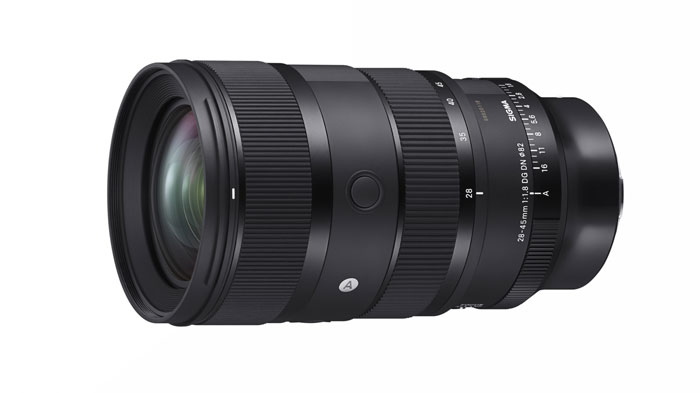
Finally, Sigma has announced the world’s first full-frame zoom lens with constant aperture, the Sigma 28-45mm F1.8 Art is a perfect lens made for shooting cinematic portraits, a perfect lens for professional wedding photographers and cinematographers
B&H Store | Amazon.com
Introducing the SIGMA 28-45mm F1.8 DG DN | Art, the First Full-Frame F1.8 Zoom Lens for Mirrorless Camera Systems
Ronkonkoma, NY – June 3, 2024 – SIGMA Corporation of America, the US subsidiary of SIGMA Corporation (CEO: Kazuto Yamaki. Headquarters: Asao-ku, Kawasaki-shi, Kanagawa, Japan) is pleased to announce the SIGMA 28-45mm F1.8 DG DN | Art lens. This is the world’s first zoom lens with a constant F1.8 aperture for full-frame mirrorless camera systems. Available for Sony E-mount and L-Mount, this new wide-to-standard zoom spans several popular focal lengths from 28mm to 45mm, with image quality comparable to prime lenses.
The SIGMA 28-45mm F1.8 DG DN | Art was developed as a full-frame successor to the SIGMA 18-35mm F1.8 DC HSM | Art (for APS-C DSLR cameras), which in 2013 became the first lens in the world to achieve F1.8 throughout the entire zoom range.
While offering the convenience of a zoom, this new lens does not compromise on optical performance. By effectively arranging 3 aspherical lens elements and 5 SLD glass elements, this lens suppresses various aberrations and achieves performance comparable to single focal length lenses, even surpassing the SIGMA 24mm F1.4 DG DN | Art and SIGMA 50mm F1.4 DG DN | Art, which have an established reputation for their optical quality.
In particular, the 28-45mm F1.8 DG DN | Art focuses on suppressing axial chromatic aberration, which is often noticeable in large-aperture lenses, to achieve images with minimal coloration on both the focus plane and bokeh, and to demonstrate high optical performance from open aperture. The minimum focusing distance is 30cm (11.8 inches) throughout the entire range, and the maximum magnification ratio of 1:4 is achieved at the 45mm focal length.
Featuring internal zoom and HLA (High-response Linear Actuator) autofocus, and an optical design that minimizes focus breathing, the SIGMA 28-45mm F1.8 DG DN | Art is well-suited for video work, including gimbal setups, thanks to its balanced design. The click/de-click switch and lockable aperture ring are designed to suit a variety of personal capture preferences, and the dust- and splash-resistant design also makes it suitable for shooting stills and video out in the elements.
The SIGMA 28-45mm F1.8 DG DN | Art lens will be available for $1,349 through authorized retailers in the US in late June 2024.
By admin, on June 2nd, 2024
We are getting strong information from the past month that Panasonic has strong plans to announce not one but a total of 3 cameras,
March 11, 2024 [check post here] – Panasonic Registers 3 NEW cameras, one of them is said to be Panasonic GH7 according to E8M_8888
Update: The total number of unreleased models are P2303A, P2302A, and P2304A.
One of them is also considered to be Panasonic GH7 [told in March 11]
On May 8, Way before other Rumor Mills We told you, to check the post here
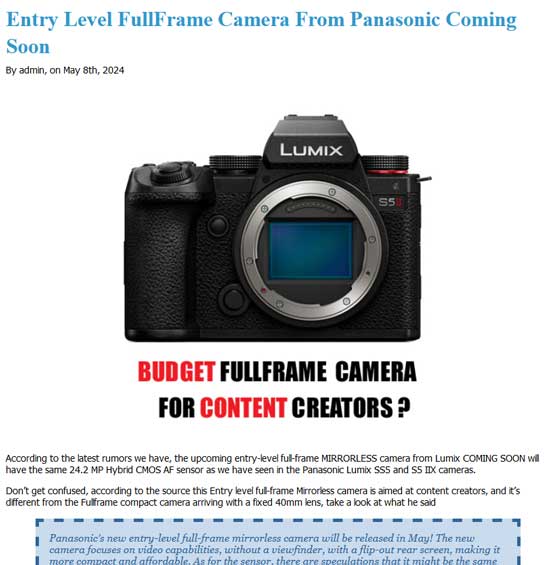
Before May 8, we got Strong Hints that Panasonic was about to announce two cameras, We have written in our post that DAY
Interestingly, two Cameras from Pansonic are coming Soon. it’s hard to believe that Panasonic has two new cameras with FF sensors coming soon, yes we do have information in the past that the compact camera will have an FF sensor but one more Entry Level Mirrorless is also coming, this particular news makes me very excited
you can check these lines in the article
Again on May 11, 2024
[ check post here ] We have received strong hints about Panasonic TWO’s new camera arriving, but we have been confused with the information provided by the source and considered the compact camera will have a Fullframne Sensor, actually, now we know the Compact has a M4/3 Sensor
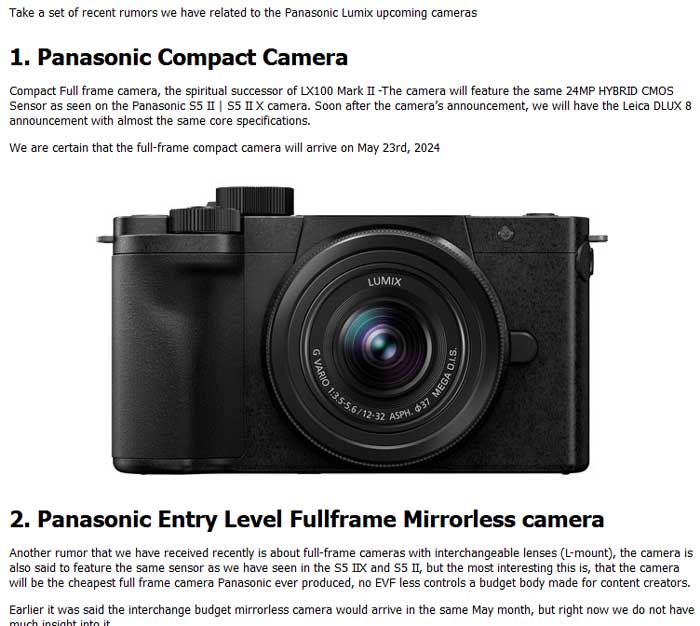
At the time of the Panasonic S9 Announcement, A user asked me
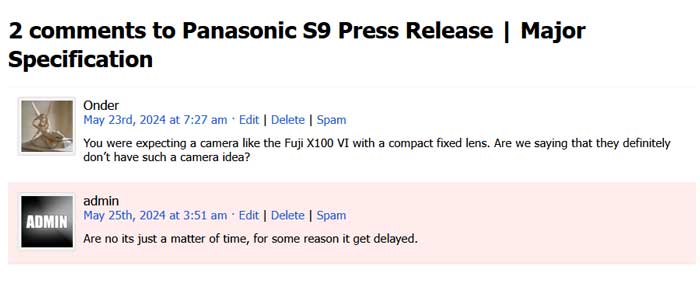
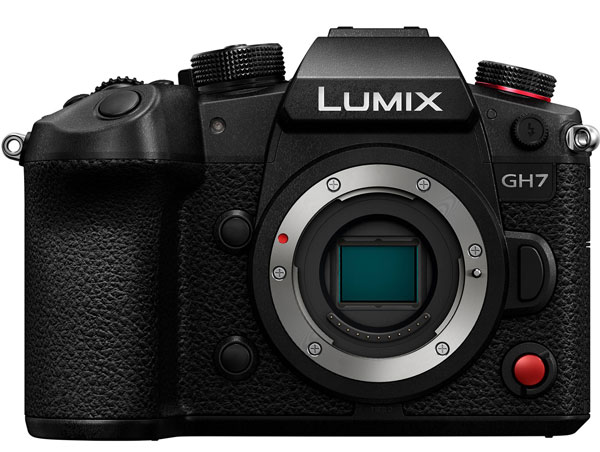
Summary, 1 Announced two more to go
After the Panasonic S9 announcement, However, we still have two more announcements from Panasonic shortly one compact and another of Panasonic GH7.
Follow us on our social pages FACEBOOK | TWITTER | INSTAGRAM, to get LIVE News and Panasonic Rumor
By admin, on May 30th, 2024
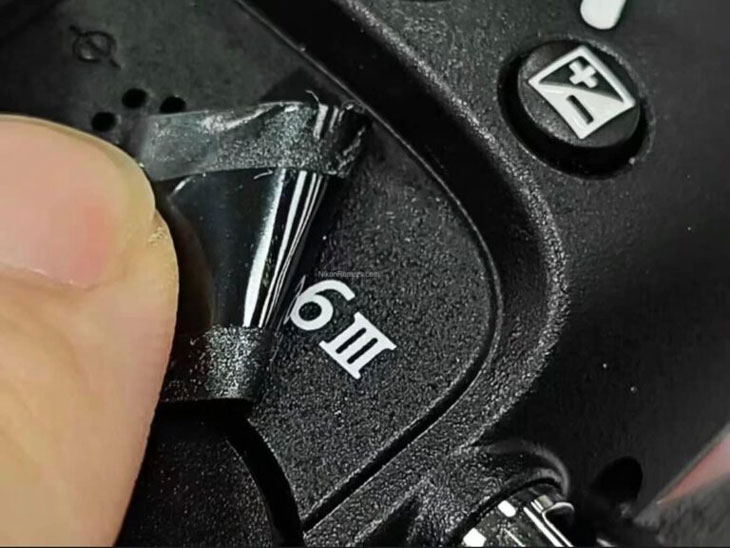
According to the latest rumors from the rumor mill, the Nikon Z6 Mark 3 camera is expected to arrive on June 11. Take a look at the set of rumored specifications of the upcoming Z6 Mark 3 camera.
Nikon Z6 Mark III specification
Pixels: 24.5 million pixels
Processor: EXPEED7 processor
Anti-shake: Level 7 anti-shake
Shutter speed: 1/16000 second
AF: 299 points
Video: 6K/60p&4K/120p 12bit N-RAW recording
4KH.265 10Bit MOV video, can be 6K oversampled 4K
FX format or DX format up to 120p.
Continuous shooting: up to 40fps FX format, 120fps DX format continuous shooting
Viewfinder: Brand new high-resolution viewfinder with 5.76 million pixels
Card slot: support CFexvressB, SD UHS-II
Battery: EL-15 battery
Set up a warm association of photographers
Additional Specs
other
Pixel displacement high-resolution photography
Easy-to-use multi-angle LCD screen
Fine shutter angle options, split the project pause rate from the shooting pause rate
Support WiFi2.4/5GHZ, Bluetooth LE connection
USB-C fast charge & HDMI Type-A connection
Inherited from the Z8 style body, smaller than the Z8
Top micro-label (same as Z8 and Z9)
PASM dial pad
Nikon Z6 mark III Shipping information
According to the previous set of information we have published a while ago the Nikon Z6 mark III camera shipping will start in July 2024. [Check here]
Follow us on our social pages FACEBOOK | TWITTER | INSTAGRAM to get live news + Nikon Rumors 24X7.
source NR.com
By admin, on May 30th, 2024
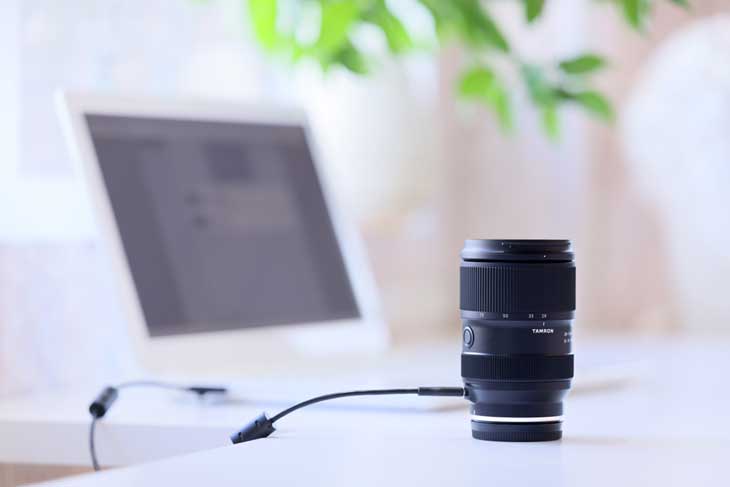
Tamron has released “TAMRON Lens Utility Mobile™” Ver.3.0, which appears to include “Delay Start,” “Focus Stopper,” “Astro Focus L
May 30, 2024, Commack, NY – TAMRON Americas, a leading provider of high-quality lenses, announces updates of the TAMRON Lens Utility, dedicated computer software, and the TAMRON Lens Utility Mobile, dedicated application for Android1 OS compatible smartphones and tablets. This update will provide additional functionality for greater convenience in the field and expands the possibilities of still and video photography. The software versions will change from the currently released Ver.2.0 to Ver.3.0, and the updated version will be available for download on May 30, 2024.
TAMRON Lens Utility and TAMRON Lens Utility Mobile Ver.3.0 overviews
October 2021 marked the release of TAMRON Lens Utility, a dedicated computer software that allows users to customize the functions of various TAMRON lenses according to their photographic and video shooting styles. In November 2022, we released TAMRON Lens Utility Mobile for Android OS, as we received many requests for the ability to customize lens functions in the field. In pursuit of even greater convenience, TAMRON has upgraded existing functions, added new functions for both the computer and mobile software, and added a new function exclusively for TAMRON Lens Utility Mobile.
We plan to further expand and enhance functions to make video production more friendly to our customers.
Additional features with the Ver.3.0 update:
● Delay Time Start (upgrade to an existing feature)
This feature delays activation of a focus shift after the Focus Set Button has been pressed to activate. This is used to avoid shaking or button noises to be recorded when the Focus Set Button is pressed, and action starts.
* In addition to the Focus Set Button on the lens, this can also be used with the Remote Set Button with the TAMRON Lens Utility Mobile.
● Focus Stopper (new feature)
This feature fixes the focus range when manual focus is operated during video shooting. This will prevent the user from passing over the focal point.
* The stopper will automatically be released when switching to AF mode.
* In addition to the Focus Set Button on the lens, this feature could also be controlled from the Remote Set Button featured in the TAMRON Lens Utility Mobile.
● Astro Focus Lock (Astro FC-L) (new feature)
This feature fixes the focus on stars, which is useful for astrophotography. The focus is shifted to infinity and operation of the focus ring will be disabled (locked). Locking the focus ring prevents the focus from slipping through inadvertent operation.
* In addition to the Focus Set Button on the lens, this can also be used with the Remote Set Button with the TAMRON Lens Utility Mobile.
● Digital Follow Focus (DFF) (new dedicated feature only for TAMRON Lens Utility Mobile)
This feature allows you to fix a focus range between two points and perform focus operations from your smartphone screen, just like follow focus techniques. The direction of rotation of the aperture and focus rings, units indicated, and EV steps can also be changed.
*Aperture ring control and EV step configuration is not supported on Nikon Z mount lenses.
By admin, on May 28th, 2024
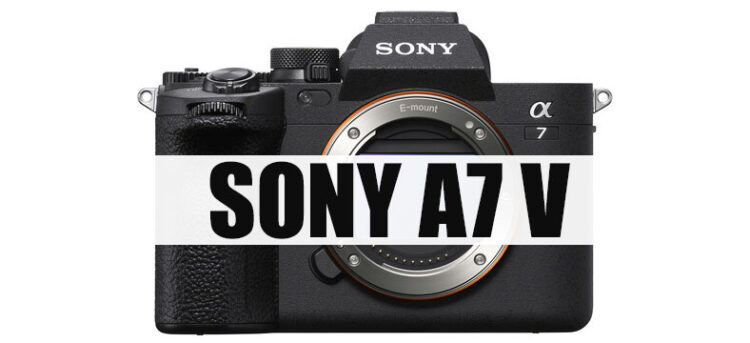
According to the latest information surfaced over the web, the Sony A7 V is set to be released in Q4 of 2024 is everything goes on schedule, the camera will have an uploadable LUT option, a dedicated AI chip for AI Auto framing, and an upscaled AF performance, the user will notice a Major upscaling in the Video performance of the camera.
The source is now so take it with a big grain of salt, as usual, at the same time we can’t ignore the set of msgs we are getting.
—- End of Rumor —-
once more rumor that recently hit our mailbox
Sony ZV-E10 II and Sony A6200
Another unusual rumor we are hearing is that Sony plans to introduce two APS-C bodies with 26 MP sensors in 2024. One is the shutter-less ZV-E10 II designed for vlogging, and the other is aimed at photography, featuring an EVF and a mechanical shutter.
—- End of Rumor # 2 —-
I think this rumor is likely to be false, since an EVF-based 26 MP budget APS-C Mirrorless will disturb the sale of the Sony A6700 camera, I don’t think Sony will do this with the A6700.
Check out more
Wild Rumors: Sony FX30 II, Sony FX30 R and Sony ZV-E1 II Coming in 2025
Follow us on our social pages FACEBOOK | TWITTER | INSTAGRAM, If you have time –>see more Sony Alpha Rumor
By admin, on May 25th, 2024

Let’s compare the Panasonic S9 versus the Sony A7C II. Starting with the comparison,
1. Sensor
we know the key difference here is the sensor resolution. Both cameras feature BSI CMOS sensors, but the Sony A7C II has a 33-megapixel Exmor R BSI CMOS sensor, whereas the Panasonic S9 uses a 24.2-megapixel sensor BSI CMOS. If we compare them side by side, the Sony A7C II will show slightly more details due to the higher-resolution sensor, specifically when you are pixel-peeping at 100% scale, as many of us do as photographers. However, the difference is minimal and not noticeable until you test both images under lab conditions.
2. AutoFocus
The autofocus sensitivity of both cameras is slightly different. The Sony A7C II’s autofocus sensitivity range is -3 EV to 20 EV, whereas the autofocus sensitivity range of the Panasonic S9 is from 0 to 18 EV., so Sony A7C II II practically more usable in low-light condition compared to the S9
3. AI integration
Regarding AI integration, the Sony A7C II camera is more advanced, with a dedicated AI chip inside it as well as dedicated AI alkgo. The autofocus capability and tracking performance of the A7C II is better compared to S9, and it can track subjects like trains, airplanes, and other moving objects. This doesn’t mean the Panasonic S9’s autofocus system is inferior or bad; it is quite good since Panasonic also uses a hybrid autofocus system. However, if you compare it with Sony, you will notice some differences. however, the S9 camera sensor is also very suitable for general-purpose photography and usage.
| Feature |
Panasonic S9 |
Sony A7C II |
| Sensor Type |
BSI CMOS |
BSI CMOS |
| Sensor Resolution |
24.2 megapixels |
33 megapixels |
| Detail Level at 100% Zoom |
Lower detail |
Higher detail |
| Autofocus Sensitivity Range |
0 EV to 18 EV |
-3 EV to 20 EV |
| AI Integration |
No dedicated AI chip |
Dedicated AI chip |
| Autofocus Capability |
Good, hybrid autofocus system |
Superior, advanced tracking performance |
| Tracking Performance |
Efficient but slightly lower than Sony |
Excellent, tracks moving objects efficiently |
| General Photography Usage |
Suitable |
Suitable |
3. Mechanical Shutter vs Electronic
Sony A7C II camera has two options: one is a mechanical shutter and the other is an electronic shutter. The Panasonic S9 remains limited to electronic only. With the help of a mechanical shutter, you get a mechanical range starting from 1/4000 of a second to 30 seconds long exposure in the Sony A7C II camera. The electronic shutter range of both cameras is the same, from 1/8000 of a second to 60 seconds. However, the Sony A7C II’s electronic shutter range limited to 1/8000 of a second to 30 seconds.
4. Continuous shooting speed
Let’s compare the continuous shooting speed with full-time autofocus support and auto exposure support. With the Panasonic S9 camera, you are able to capture approximately 30 frames per second with the help of the electronic shutter. The Sony A7C II camera’s continuous shooting speed is limited to 10 frames per second with the mechanical shutter.
5. Pre-shooting buffer
One more thing that you get with Panasonic that will help you as a photographer is a pre-shooting buffer of approximately 0.50 seconds, which effectively counts 15 frames per second in the Panasonic S9 camera, which is absent in the Sony A7C II.
6. Pixel Shift High-Resolution Mode
Advantages associated with the Panasonic S9 camera include sensor-shift high-resolution mode. With the Panasonic S9 camera, you can capture 96-megapixel high-resolution images while using this mode, but there is one condition: you have to place your camera on a tripod, and the subject should be still.
Being a Panasonic camera, you also get some abilities of post-focus mode, so you can change the focus point after taking a shot, but all these facilities are only available in RAW files, not available in JPEGs.
| Feature |
Panasonic S9 |
Sony A7C II |
| Shutter Options |
Electronic only |
Mechanical and electronic |
| Mechanical Shutter Range |
Not available |
1/4000 sec to 30 sec |
| Electronic Shutter Range |
1/8000 sec to 60 sec |
1/8000 sec to 30 sec |
| Continuous Shooting Speed |
30 fps (electronic shutter) |
10 fps (mechanical shutter) |
| Pre-Shooting Buffer |
Yes, 0.50 seconds (~15 fps) |
No |
| High-Resolution Mode |
Yes, 96 megapixels (requires tripod and still subject) |
No |
| Post Focus Mode |
Yes (RAW files only) |
No |
7. Display
Sony A7C Mark II camera features an electronic viewfinder of 0.39 inch OLED, 2.36 million resolution, whereas the electronic viewfinder is completely absent in the Panasonic S9 camera. Both cameras give you a vari-angle display screen for composition freedom, but resolution-wise, the Panasonic S9 display screen is much more powerful with a 1.84 million dot resolution compared to the Sony A7C II with 1.04 million resolution.
8. Handgrip
Body design and hand grip-wise, the Sony A7C II will give a much better experience to a professional photographer compared to the Panasonic S9. For the Panasonic S9, you have to buy an additional grip; without that, it is not able to be used properly even for 30 minutes while holding your camera with a lens. It is completely a grip-less camera.
| Feature |
Panasonic S9 |
Sony A7C II |
| Electronic Viewfinder (EVF) |
Absent |
0.39 inch OLED, 2.36 million resolution |
| Display Screen |
Vari-angle, 1.84 million dot resolution |
Vari-angle, 1.04 million resolution |
| Body Design and Hand Grip |
Requires additional grip for proper use |
Better experience for professional photographers |
| Ease of Use |
Difficult to use without additional grip |
Comfortable to use even without additional accessories |
9. Video Mode
Let’s compare the video specifications of both cameras since both cameras are made for content creators. Let’s see which camera is best for you.
Regarding recording formats in both cameras, the Panasonic Lumix S9 supports MOV format, MP4 format, and MP4 HEVC format, but is missing the All-I intra-recording format. The Sony A7C II supports the XAVC S, XAVC SI (which is All-I intra format), as well as the latest XAVC HS.
10. Video Time Limits in Panasonic S9
The Panasonic S9 can capture up to 6K video at 60 frames per second, with a maximum of 10 minutes only. After that, the recording will stop, and you have to start it again. No 6K recording video mode is available in the Sony A7C Mark II.
The Sony A7C II camera captures 4K at 60 frames per second, and the Panasonic S9 also captures 4K at 60 frames per second, but with a 1.5x crop. In both cameras, you have to face a crop while recording 4K at 60 frames per second. However, in the Panasonic S9 camera, the recording time of 4K 60 FPS videos is limited to 15 minutes only, whereas in the Sony A7C Mark II camera, you can record videos until the camera gets overheated. Additionally, since the All-I intra format is available even while shooting 4K at 60 FPS in the Sony A7C Mark II, the overall bit rate jumps to 600 megabits per second (Mbps).
The Biggest SAD part of Panasonic S9 even the Full HD video recording mode of the Panasonic S9 Camera is limited to 20 Minutes Only, its look like the Camera is only designed to serve the TIK-TOK or You Tube SHORTS Creators ONLY.
| Feature |
Panasonic S9 |
Sony A7C II |
| Recording Formats |
MOV, MP4, MP4 HEVC |
XAVC S, XAVC SI (All-I intra), XAVC HS |
| 6K Video Recording |
Yes, up to 60 fps (10-minute limit) |
No Limit |
| 4K Video Recording |
Yes, up to 60 fps (1.5x crop, 15-minute limit) |
Yes, up to 60 fps (1.5x crop, limited by overheating) |
| Maximum Bit Rate |
200 Mbps (6K/5.9K) |
600 Mbps (4K All-I intra) |
| Recording Time Limits |
10 minutes (6K), 15 minutes (4K 60 fps) |
No fixed limit (until overheating) |
| Crop Factor in 4K 60 fps |
1.5x |
1.5x |
Panasonic S9’s 6K and 5.9K recording are limited to the MP4 HEVC format, with recording going up to a maximum of 200 megabits per second (Mbps). So, that’s a very limited amount of data you are getting even when you are recording 6K or 5.9K with the Panasonic S9, and the time limit is also there of 10 minutes.
Detailed Comparison
| Camera Name |
LUMIX S9 |
Panasonic A7C MK2 |
| Audio rec. method |
MPEG-4 AVC/H.264
H.265/HEVC |
MPEG-4 AVC/H.264
MPEG-H HEVC/H.265 |
| Recording Format |
MOV
MP4
MP4 Lite |
XAVC S,
XAVC SI,
XAVC HS |
| 6K |
6K 29.97p 200Mbps
(3:2 / 17:9)
5.9K 29.97p 200Mbps
(16:9) |
– |
| 4K |
FF
4K 29.97p – 150Mbps 4:2:2, 10bit LGOP
C4K 29.97p – 150Mbps 4:2:2
10bit LGOP
APS-C – C4K 59.94p – 200Mbps – 4:2:2 10bit LGOP
4K 47.95p – 200Mbps
4:2:0 10bit LGOP |
~60p – UHD
ALL-I /LGOP
~600Mbps |
| FHD |
~119.88p – 150Mbps – 4:2:2 10bit – LGOP |
~60p
ALL-I /LGOP
~222Mbps |
| high speed |
4K APS-C 60fps
4:2:0 10bitFHD 180fps 100Mbps 4:2:0 10bit |
~120fps |
| Video Crop |
4K 60p APS-C
4K 30p Full |
None (4K 30p)
S35 (4K 60p) |
Cont. shooting
|
6K 10 minutes
4K 15 minutes
FHD 20 minutes |
Unlimited |
| Internal recording |
4K 60p 4:2:2 10bit |
4K 60p 4:2:2 10bit |
| Time Lapse Video |
correspondence |
– |
| Video rec. function |
LUT Assist
HLG Assist
Anamorphic Desqueeze..and..Timecode
Waveform
Monitor
Vectorscope
Zebra
Color
Barney
Control Red Frame |
TC/UB
Zebra
Peaking
Active Electronic IS
Hybrid AF
HLG
Proxy
AF Transition Speed
AF Shift Sensitivity
Flexible Exposure Settings
Focus Map
Breathing Compensation |
| Video Profile |
V-Log
CinelikeD2
CinelikeV2
Like709
Like2100
Like2100FL
Real-time LUT |
PP1-PP11 |
Electronic IS
|
Active IS |
Active IS |
11. Panasonic S9 Professional videography features for cinematic use
The Panasonic S9 camera uses the same software that is used in the Panasonic S5 II, so you get all the features that are present in professional cameras even though you have to face recording time limits even in Full HD. But at the same time, you are getting features like anamorphic de-squeeze, time code functionality, waveform monitor, and vector scope. These are some features that a professional may require while shooting video with a camera available in the S9. The recording time limit is two hours in full HD and should be removed.
12. Gyro-based image stabilization system and focus breathing compensation
The Sony A7C Mark II is a bit more vlogger-oriented camera. That’s why SONY is giving gyro-based image stabilization for stability in handheld V-Log. At the same time, due to the presence of a dedicated AI chip, the camera is now able to do AI auto-framing of the subjects and track the subject with its movement. And finally Focus Breathing compensation for flawless AF performance.
Verdict: Panasonic S9 Core Specs very appealing, but at the same time the time limit in video ruins everything, So Sony A7C Mark II is more recommended over the Panasonic S6
Get Sony A7C II from Amazon.com | B&H Store
|
KEEP THIS BLOG ALIVE - Support New Camera Buy Canon Lenses, Buy Music CD or Digital Camera at amazon it helps this site, and you do not pay anything extra, it is just a way to help support this site.

|















